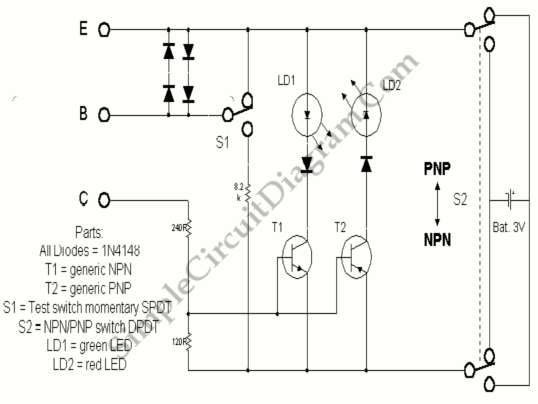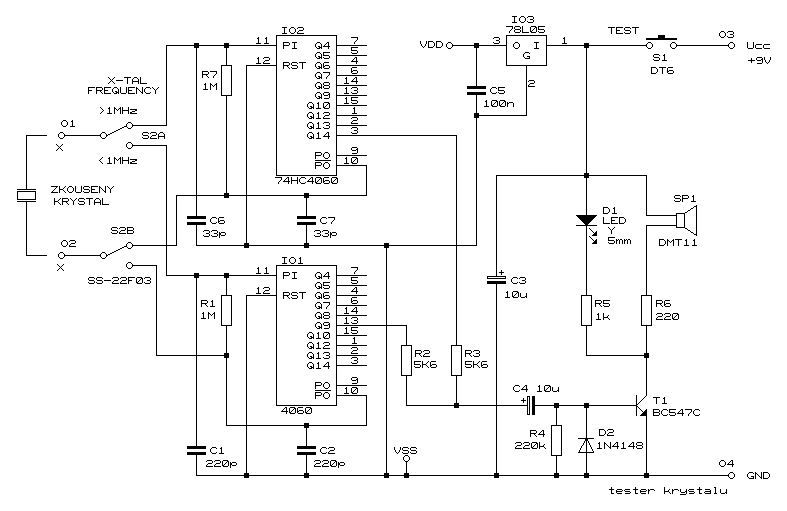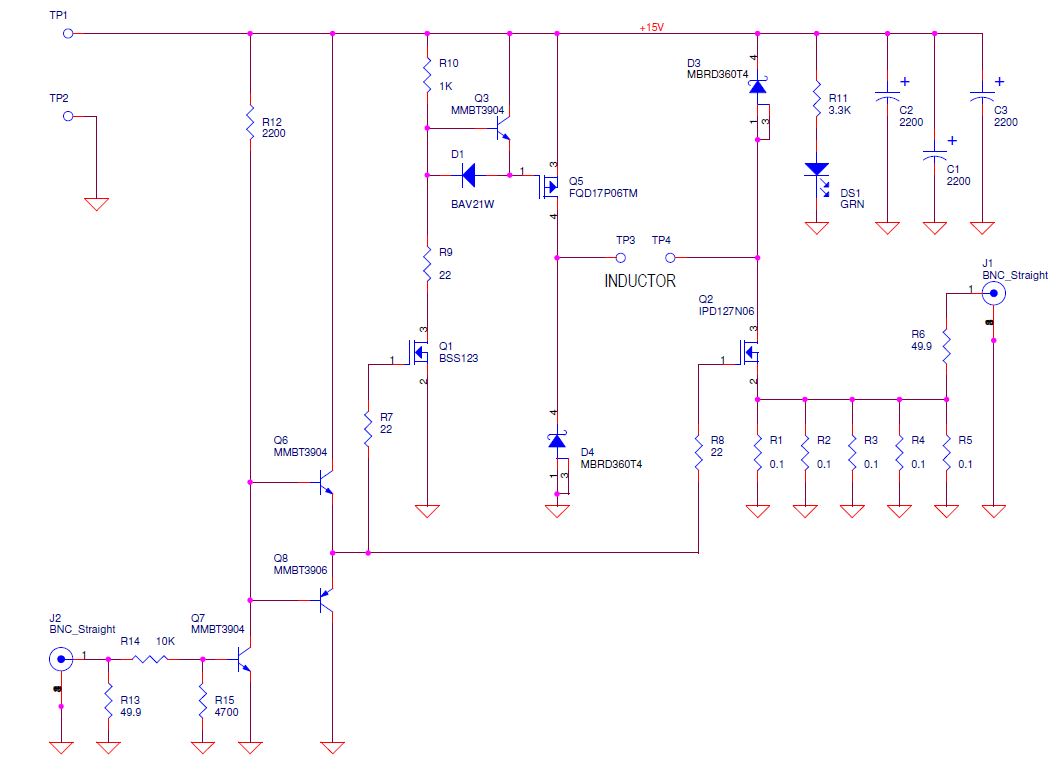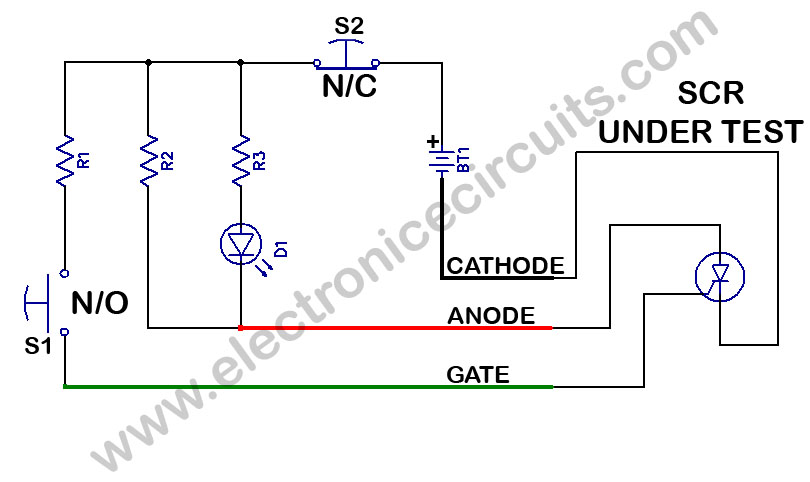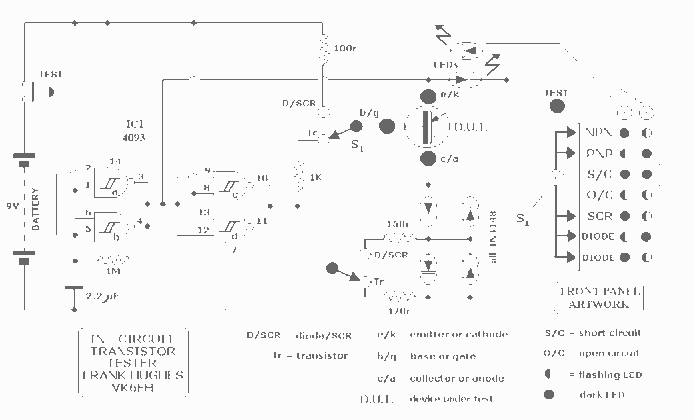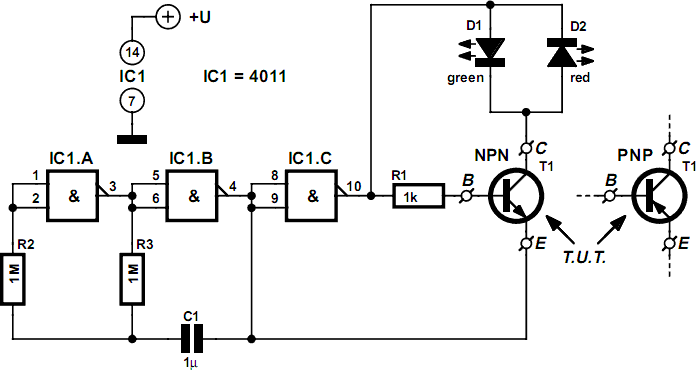
Three-State Continuity Tester
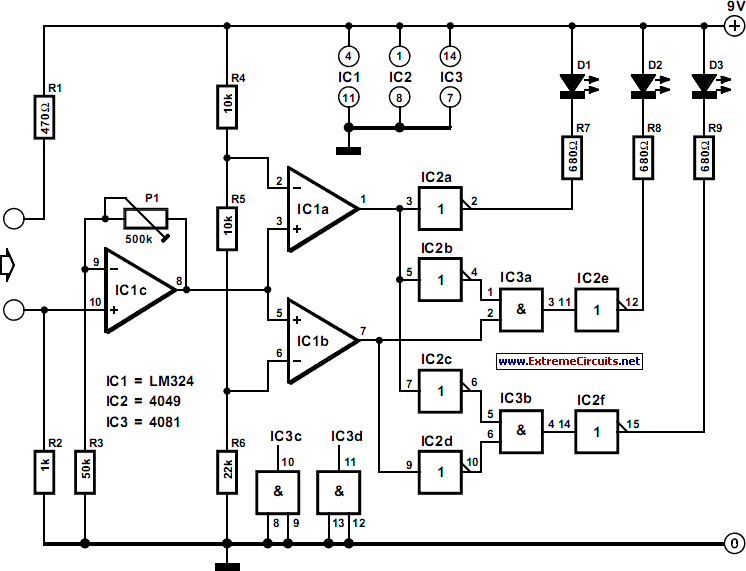
The continuity tester can distinguish between high, medium, and low-resistance connections. When there is a conductive path between the inputs, connected to small probes, a current flows from the +9 V line to ground through resistors R1 and R2. The resulting potential difference across R2 is utilized to determine the transfer resistance. Operational amplifier IC1c amplifies the potential difference across R2 to a level set by potentiometer P1. A window comparator, consisting of IC1a and IC1b, compares the output of IC1c to two predetermined levels established by potential divider resistors R4 and R6. Based on the outputs of the two comparators, three light-emitting diodes (LEDs) are activated through the gates and inverters in IC3 and IC2, respectively, indicating the transfer resistance in three categories. When the resistance is high, the green LED D3 lights; for medium resistance, the yellow LED D2 lights; and for low resistance, the red LED D1 lights. The thresholds for LED activation are adjustable using P1, but the minimum value is dependent on the potential difference across R2. Lowering this potential difference can allow for the detection of lower transfer resistances; however, it would increase the test current through R2. Under specified conditions, the circuit draws approximately 17 mA in its quiescent state, with each LED adding around 10 mA during operation. The LM324 (IC1) can function with a single supply voltage ranging from 5 to 18 V. Resistor R1 prevents the input voltage from exceeding the supply voltage, which is not permissible. The LEDs are directly driven by the inverters in the 4049 (IC2), capable of switching currents up to 20 mA to ground.
The continuity tester circuit is designed to accurately assess the resistance of connections by providing a clear visual indication through the use of LEDs. The operational amplifier IC1c plays a crucial role in amplifying the voltage across R2, which is critical for determining the resistance levels. The window comparator configuration, utilizing IC1a and IC1b, enables precise comparison of the amplified voltage against predefined thresholds set by resistors R4 and R6. This ensures that the circuit can categorize the resistance into three distinct ranges: high, medium, and low.
The use of potentiometer P1 allows for user calibration of the resistance thresholds, providing flexibility in the circuit's operation. This adjustability is essential for applications requiring varying sensitivity levels. The design also incorporates a trade-off between the potential difference across R2 and the test current, which must be managed to maintain circuit integrity and performance.
The power supply requirements of the LM324 ensure compatibility with a range of applications, and the inclusion of R1 is a necessary safety feature to protect the operational amplifier from excessive input voltages. The driving capability of the 4049 inverters ensures that the LEDs can operate effectively, providing a reliable visual output that is critical in diagnostic and testing scenarios. Overall, this continuity tester circuit combines functionality, adaptability, and safety, making it a valuable tool in electronic testing and maintenance.The continuity tester can distinguish between high-, medium-, and low-resistance connections. When there is a conductance between the inputs, which are linked to small probes, a current flows from the +9 V line to earth via R1 and R2. The consequent potential difference, p. d. , across R2 is used to determine the transfer resistance. Operational amp lifier IC1c amplifies the p. d. across R2 to a degree that is set with P1. A window comparator, IC1a and IC1b, likens the output of IC1c to the two levels set with potential divider R4 R6. Depending on the state of the outputs of the two comparators, three light-emitting diodes (LEDs) are driven via the gates and inverters contained in IC3 and IC2 respectively in such a way that they indicate the transfer resistance in three categories.
When the resistance is high, green diode D3 lights; when it is of medium value, yellow diode D2 lights, and when it is low, red diode D1 lights. The levels at which the diodes light is set with P1, but note that in any case the minimum value depends on the p.
d. across R2. It is possible to reduce the value of the p. d. to enable lower transfer resistances to be detected, but this would mean an increase in the test current through R2. With values as specified, the circuit in its quiescent state draws a current of about 17 mA, but in operation each LED adds about 10 mA to this.
The LM324 (IC1) may be operated from a single supply line: R1 prevents the voltage at the input from reaching the level of the supply line (which is not permissible). The supply voltage may be 5 18 V. The LEDs are driven directly by the inverters in the 4049 (IC2), which can switch currents of up to 20mA to earth.
🔗 External reference
The continuity tester circuit is designed to accurately assess the resistance of connections by providing a clear visual indication through the use of LEDs. The operational amplifier IC1c plays a crucial role in amplifying the voltage across R2, which is critical for determining the resistance levels. The window comparator configuration, utilizing IC1a and IC1b, enables precise comparison of the amplified voltage against predefined thresholds set by resistors R4 and R6. This ensures that the circuit can categorize the resistance into three distinct ranges: high, medium, and low.
The use of potentiometer P1 allows for user calibration of the resistance thresholds, providing flexibility in the circuit's operation. This adjustability is essential for applications requiring varying sensitivity levels. The design also incorporates a trade-off between the potential difference across R2 and the test current, which must be managed to maintain circuit integrity and performance.
The power supply requirements of the LM324 ensure compatibility with a range of applications, and the inclusion of R1 is a necessary safety feature to protect the operational amplifier from excessive input voltages. The driving capability of the 4049 inverters ensures that the LEDs can operate effectively, providing a reliable visual output that is critical in diagnostic and testing scenarios. Overall, this continuity tester circuit combines functionality, adaptability, and safety, making it a valuable tool in electronic testing and maintenance.The continuity tester can distinguish between high-, medium-, and low-resistance connections. When there is a conductance between the inputs, which are linked to small probes, a current flows from the +9 V line to earth via R1 and R2. The consequent potential difference, p. d. , across R2 is used to determine the transfer resistance. Operational amp lifier IC1c amplifies the p. d. across R2 to a degree that is set with P1. A window comparator, IC1a and IC1b, likens the output of IC1c to the two levels set with potential divider R4 R6. Depending on the state of the outputs of the two comparators, three light-emitting diodes (LEDs) are driven via the gates and inverters contained in IC3 and IC2 respectively in such a way that they indicate the transfer resistance in three categories.
When the resistance is high, green diode D3 lights; when it is of medium value, yellow diode D2 lights, and when it is low, red diode D1 lights. The levels at which the diodes light is set with P1, but note that in any case the minimum value depends on the p.
d. across R2. It is possible to reduce the value of the p. d. to enable lower transfer resistances to be detected, but this would mean an increase in the test current through R2. With values as specified, the circuit in its quiescent state draws a current of about 17 mA, but in operation each LED adds about 10 mA to this.
The LM324 (IC1) may be operated from a single supply line: R1 prevents the voltage at the input from reaching the level of the supply line (which is not permissible). The supply voltage may be 5 18 V. The LEDs are driven directly by the inverters in the 4049 (IC2), which can switch currents of up to 20mA to earth.
🔗 External reference
Warning: include(partials/cookie-banner.php): Failed to open stream: Permission denied in /var/www/html/nextgr/view-circuit.php on line 713
Warning: include(): Failed opening 'partials/cookie-banner.php' for inclusion (include_path='.:/usr/share/php') in /var/www/html/nextgr/view-circuit.php on line 713
